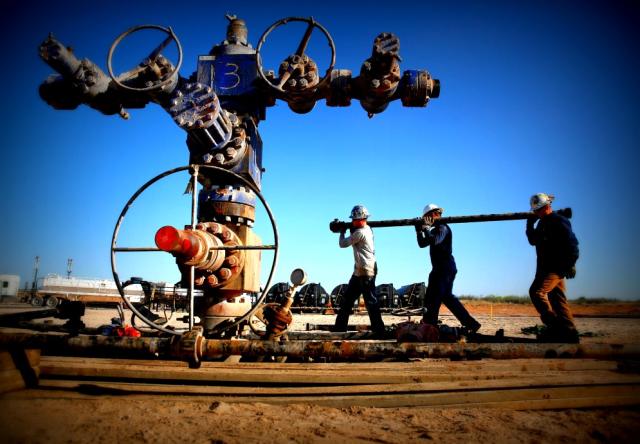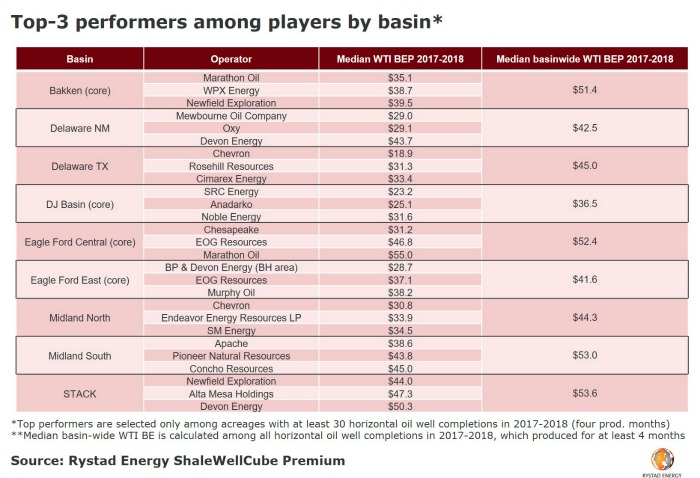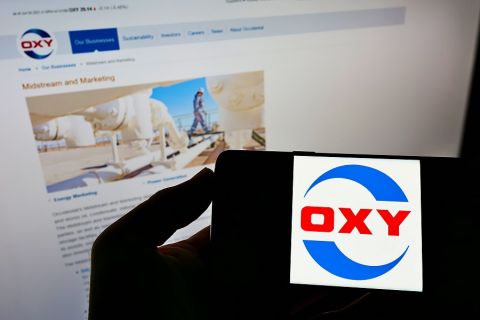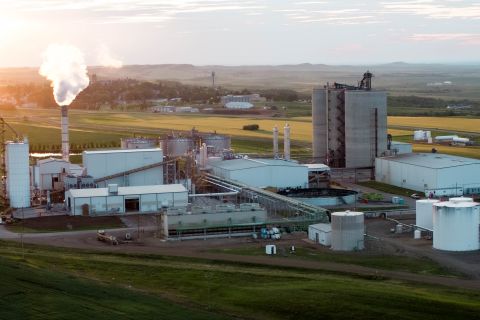
Workers haul off pipe after testing on WPX Energy’s Delaware Basin acreage in Loving County, Texas, in March 2017. (Source: Tom Fox/Hart Energy)
As oil prices appear to be settling at slightly lower prices than the hopeful peak periods achieved in 2018, industry players are bearing down on making the economics of plays work without a boom cycle.
Research and consulting firm Rystad Energy gave a look at top performers among oil and gas producers as well as most the lucrative acreage positions in U.S. shale plays. Those breakeven prices, tweaked by seasoned shale drillers, have responded.
Operators in the U.S. shale basins continue to prove they can make the economics work with West Texas Intermediate (WTI) prices in more moderate ranges. In fact, over the past two years, breakeven prices on the best acreage generally ranged between $30 to $40 per barrel WTI, with the top-notch acreage generating returns at below $20, according to Rystad.
Using the top 50 acreage positions with the lowest median breakeven prices, Rystad Energy partner Artem Abramov noted that even the acreage positions at the low end of the commerciality scale exhibit median WTI breakevens of roughly $46 per barrel. This suggests that a $50 WTI environment will not act as a show-stopper for current U.S. shale oil activity, he said.
“Even at $45 per barrel WTI, 40% of U.S. shale oil projects will still thrive,” Abramov wrote in the Feb. 13 report.
For example, Chevron Corp., one of the top performers per Rystad, had a median breakeven price on the Texas portion of its Delaware Basin operations at $18.90 WTI—the lowest noted in the Rystad report.
Still, the report found the majority of median breakevens concentrated in the $30 to $45 per barrel range, which Abramov said were in areas where activity has evolved to the development phase
He did note certain factors could make particular operators even more profitable. These included “excellent operational performance, outstanding acreage quality and unique features related to ownership of mineral rights.”

“In many basins, operators that were not viewed as basin master several years ago have nevertheless managed to complete their way to excellence through high-grading, optimization of well design, cost structure and initiation of a full-scale development program,” Abramov said.
He also cautioned that some of the largest players may not appear among the top performers because they have test programs on less prospective acreage.
Starting in the Bakken, the Rystad report found the top three performers were Marathon Oil Corp., WPX Energy Inc. and Newfield Exploration Co.
In the portion of the Delaware Basin in New Mexico, Mewbourne Oil Co. Inc., Occidental Petroleum Corp. and Devon Energy Corp. topped peers on the Rystad list. While in the Texas portion, top Delaware operators were led by Chevron followed by Rosehill Resources Inc. and Cimarex Energy Co.
Chevron also headed up the Rystad ranking of North Midland Basin players followed by Endeavor Energy Resources Resources LP and SM Energy Co. Meanwhile, the southern Midland Basin featured Apache Corp., Pioneer Natural Resources Co. and Concho Resources Inc. as top players.
Rystad divided the Eagle Ford Shale into Central Core and East Core groups. Chesapeake Energy Corp. led Rystad’s Eagle Ford Central group followed by EOG Resources Inc. and Marathon Oil. Meanwhile, BP Plc and Devon Energy dominated the Eagle Ford East group followed by EOG Resources and Murphy Oil Corp.
In the Denver-Julesburg Basin, SRC Energy Inc., Anadarko Petroleum Corp. and Noble Energy Inc. led basin-wide breakevens, according to Rystad.
Lastly, Rystad found that Midcontinent Stack players faced higher breakeven hurdles. Still, Newfield Exploration held the lowest median breakeven at $44 with Alta Mesa Holdings LP and Devon Energy close behind.
The analysis included in the Rystad report looked at acreage with at least 30 horizontal oil completions drilled between 2017 and 2018 with more than three monthly production reports. The firm defined acreage as a combination of operator and sub-basin, looked at median, P-25 and P-75 WTI breakevens and discounted these calculations by 10%.
Recommended Reading
SLB to Acquire Majority Stake in Aker Carbon Capture
2024-03-31 - SLB and Aker Carbon Capture plan to combine their technology portfolios, expertise and operations platforms to bring carbon capture technologies to market faster and more economically, SLB said in a news release.
Occidental Reports ‘Great Progress’ on Net-zero Pathway, DAC
2024-02-21 - Most of Occidental Petroleum’s planned $600 million investment in emerging low-carbon ventures for 2024 will go to direct air capture facility STRATOS, CEO Vicki Hollub says.
Red Trail Energy Issues Carbon Removal Credits
2024-03-06 - Red Trail Energy’s CO2 removal credits is the largest durable carbon removal project registered on the Puro Registry to date.
1PointFive, AT&T Enter Carbon Removal Pact
2024-03-13 - 1PointFive said it is also participating in AT&T’s Connected Climate Initiative to collaborate on carbon removal solutions like direct air capture.
Trace Carbon Solutions Applies for First Phase of Class VI Wells at Evergreen Hub
2024-03-12 - Trace is applying for its subsidiary Evergreen Sequestration Hub to be allowed to permanently sequester CO2 in underground geological formations in Louisiana.





